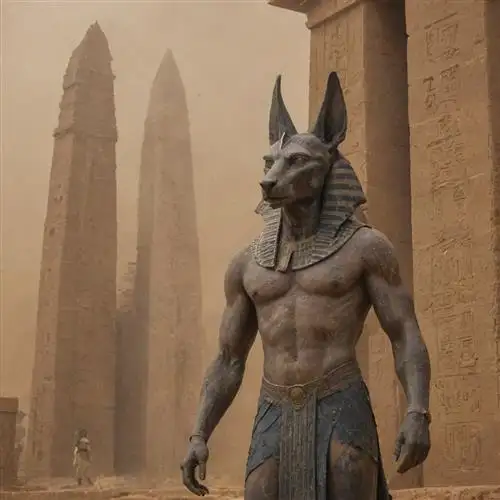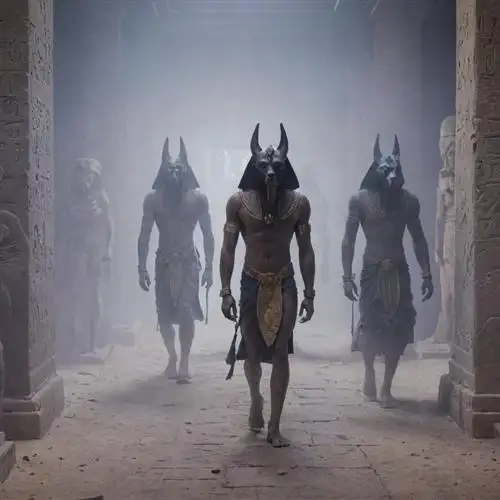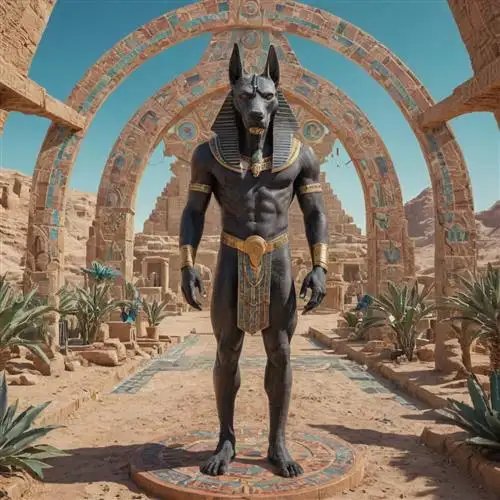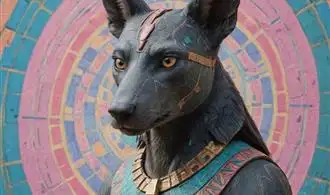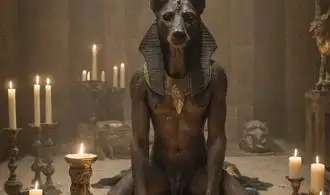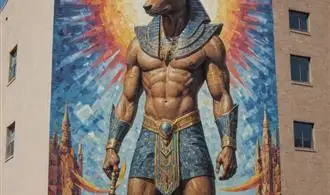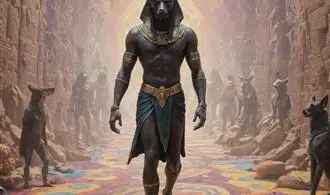
The Origin of Anubis Worship
The origin of Anubis worship in ancient Egypt can be traced back to the predynastic period, when this jackal-headed deity emerged as a significant figure in the funerary and afterlife beliefs of the Egyptian people. Anubis, often depicted as a jackal or a man with a jackal head, was closely associated with mummification, the protection of the dead, and the journey to the afterlife.
One of the primary reasons for the prominence of Anubis in ancient Egyptian religion was his role as the guardian of the necropolis, the sacred burial grounds where the dead were interred. Jackals were often observed near these burial sites, scavenging for food, which led to the belief that Anubis was responsible for guiding and protecting the deceased on their journey to the afterlife.
Additionally, Anubis was closely linked to the mummification process, as he was believed to have been the deity who embalmed and prepared the body of the deceased for the afterlife. This association with mummification reinforced Anubis' importance in the Egyptian funerary rituals and his status as a deity of the underworld.
The worship of Anubis was widespread throughout ancient Egypt, with temples and shrines dedicated to him found in various locations, including Abydos, Cynopolis, and Assiut. These sites were often the focus of important funerary ceremonies and rituals, further solidifying Anubis' role as a central figure in the Egyptian belief system.
Anubis and the Afterlife
Anubis, the jackal-headed god of ancient Egyptian mythology, played a crucial role in the afterlife rituals and beliefs of the ancient Egyptians. As the patron deity of embalmment and the protector of the dead, Anubis held a position of immense significance in the complex cosmology of the ancient Egyptian religious system.
In the afterlife, Anubis was responsible for the mummification process, ensuring the proper preservation of the deceased's physical body. This intricate ritual was believed to be essential for the successful transition of the individual's soul, or "ka," into the next life. Anubis would oversee the embalming procedure, guiding the embalmers and ensuring the proper application of sacred oils and bandages.
Furthermore, Anubis was the deity who presided over the crucial "weighing of the heart" ceremony, which determined the fate of the deceased. In this ritual, the heart of the deceased was weighed against the feather of Ma'at, the goddess of truth and justice. If the heart was found to be pure and righteous, the individual was deemed worthy of entering the afterlife. Anubis played a central role in this judgment, ensuring the accuracy and fairness of the process.
Interestingly, the association of Anubis with death and the afterlife has led to some controversy and misunderstandings. While Anubis was indeed the guardian of the dead, he was not a figure of darkness or evil. On the contrary, Anubis was seen as a benevolent and protective deity, guiding the deceased through the challenges of the afterlife and ensuring their successful transition to the next phase of existence.
The symbolism of Anubis, with his distinctive jackal head, has also been the subject of much discussion and interpretation. The jackal was chosen as Anubis' animal form due to its association with cemeteries and the ability to navigate the liminal spaces between the living and the dead. This symbolism reinforced Anubis' role as a mediator between the two realms, facilitating the deceased's journey to the afterlife.
Symbolism of the Jackal-Headed God
Anubis, the enigmatic jackal-headed deity of ancient Egyptian mythology, has long been a source of fascination and scholarly debate. This revered figure, often depicted with the head of a jackal or wild dog, holds a unique and multifaceted symbolism that extends far beyond the surface-level interpretations often presented.
At the core of Anubis' symbolism lies the jackal, a creature that was deeply revered in ancient Egyptian culture. Jackals were believed to inhabit the liminal spaces between the world of the living and the realm of the dead, making them the perfect embodiment of the transition from life to the afterlife. This association with the border between worlds positioned Anubis as a gatekeeper, guiding the deceased through the perilous journey to the afterlife.
Beyond the jackal's symbolic connection to the afterlife, the animal's physical attributes also contributed to Anubis' representation. Jackals were known to scavenge and feed on the dead, leading to their association with the embalming and mummification processes. Anubis, as the god of embalming and the protector of the dead, was tasked with ensuring the proper preparation of the deceased for their journey to the afterlife.
The color black, which is often used to depict Anubis, holds deep significance within the Egyptian belief system. Black was seen as the color of the fertile soil of the Nile river, which was the source of life and rebirth. Additionally, the black color of Anubis' skin was thought to represent the color of the mummified body, further solidifying his role as the guardian of the dead and the embalming process.
Interestingly, Anubis' dual role as both a protector of the dead and a figure associated with the judgement of the deceased has led to some controversy and conflicting interpretations. While Anubis was primarily responsible for guiding the dead through the afterlife and ensuring their proper preparation, he was also believed to play a role in the weighing of the heart ceremony, where the deceased's soul was judged before the gods.
This duality, where Anubis is both a benevolent guardian and a potentially judgmental figure, has led to a complex and nuanced understanding of his symbolism. Some scholars argue that this reflects the ancient Egyptians' recognition of the dual nature of death, where it is both a necessary transition and a potential source of judgment or consequences.
Anubis in Modern Culture
Anubis, the enigmatic jackal-headed deity of ancient Egyptian mythology, has transcended the realms of antiquity to captivate the imaginations of modern audiences. As the god of the dead, embalming, and the underworld, Anubis' symbolism has evolved, becoming a powerful icon in contemporary culture. From fashion and art to occult practices and pop culture references, the enduring legacy of Anubis continues to intrigue and inspire.
In the realm of fashion, Anubis' striking visual representation has become a sought-after motif. Designers have incorporated the jackal-headed figure into a variety of garments and accessories, from bold t-shirt designs to intricate jewelry pieces. This fusion of ancient Egyptian iconography and modern aesthetics has resonated with a global audience, reflecting the timeless appeal of Anubis' symbolic power.
Beyond the realm of fashion, Anubis' presence can be observed in the world of art. Contemporary artists have drawn inspiration from the deity's enigmatic nature, reinterpreting the iconic image through a diverse range of media. From striking paintings and sculptures to digital illustrations, Anubis has become a canvas for artists to explore themes of mortality, the afterlife, and the mysteries of the divine.
The occult and esoteric realms have also embraced the symbolism of Anubis. Many modern pagan and Wiccan practices have incorporated Anubis-centric rituals and invocations, believing the deity to be a powerful guardian of the dead and a guide through the underworld. Why Anubis Rituals are the Key to Unlocking Your Spiritual Power delves deeper into the significance of Anubis-focused rituals in unlocking spiritual potential.
In the realm of pop culture, Anubis' iconic presence has found a prominent place. From feature films and television series to video games and comic books, the jackal-headed deity has become a recognizable figure, captivating audiences with its otherworldly allure. This widespread inclusion in mainstream media further emphasizes the enduring fascination with Anubis and the ancient Egyptian pantheon.
Controversies and Misconceptions
The symbolism of Anubis, the ancient Egyptian god of the dead, has long been a subject of fascination and controversy. While Anubis is widely recognized as the jackal-headed deity associated with mummification, embalming, and the afterlife, there are numerous misconceptions and debates surrounding his true significance and role within the Egyptian pantheon.
One of the primary controversies surrounding Anubis is the interpretation of his physical features. The jackal-headed representation of the god has often been associated with the wild and untamed aspects of death, leading to the misconception that Anubis was a malevolent or fearsome deity. However, this interpretation fails to account for the complex and multifaceted nature of Anubis's role in ancient Egyptian beliefs.
Contrary to popular belief, Anubis was not solely a deity of death and the underworld, but rather a protector and guide for the deceased. His jackal-like features were not a symbol of his ferocity, but rather a representation of his keen senses and ability to navigate the treacherous realms of the afterlife. Anubis was responsible for the mummification process, ensuring the proper preservation of the deceased's body, and he also played a crucial role in the judgment of the dead, weighing their hearts against the feather of truth.
Another area of controversy surrounding Anubis is the perceived connections between his symbolism and that of other ancient Egyptian deities. Some scholars have argued that Anubis's role as a psychopomp, or guide of souls, was influenced by or shared with other gods, such as Wepwawet or Upuaut. While these connections are worth exploring, they often oversimplify the complex and multifaceted nature of Anubis's significance within the Egyptian religious system.
Perhaps one of the most intriguing and controversial aspects of Anubis's symbolism is the ongoing debate surrounding his origins and the evolution of his worship over time. 10 Fascinating Facts About the Egyptian God Anubis delves deeper into the historical and cultural contexts that shaped the cult of Anubis, shedding light on the nuanced and often misunderstood aspects of his legacy.

